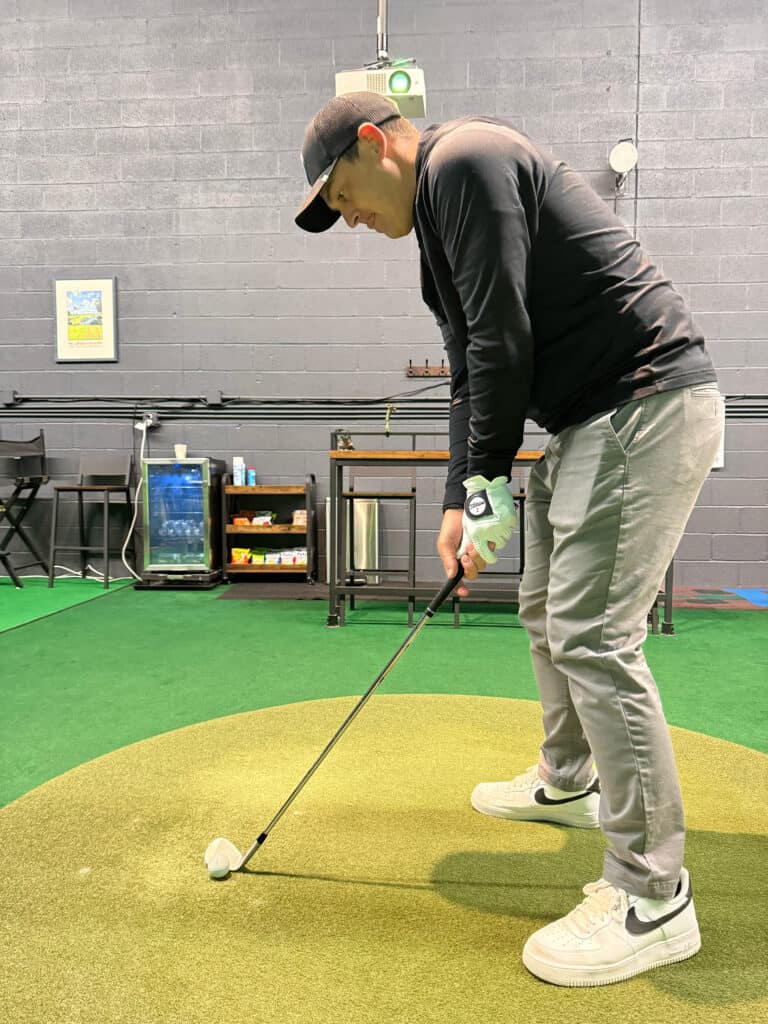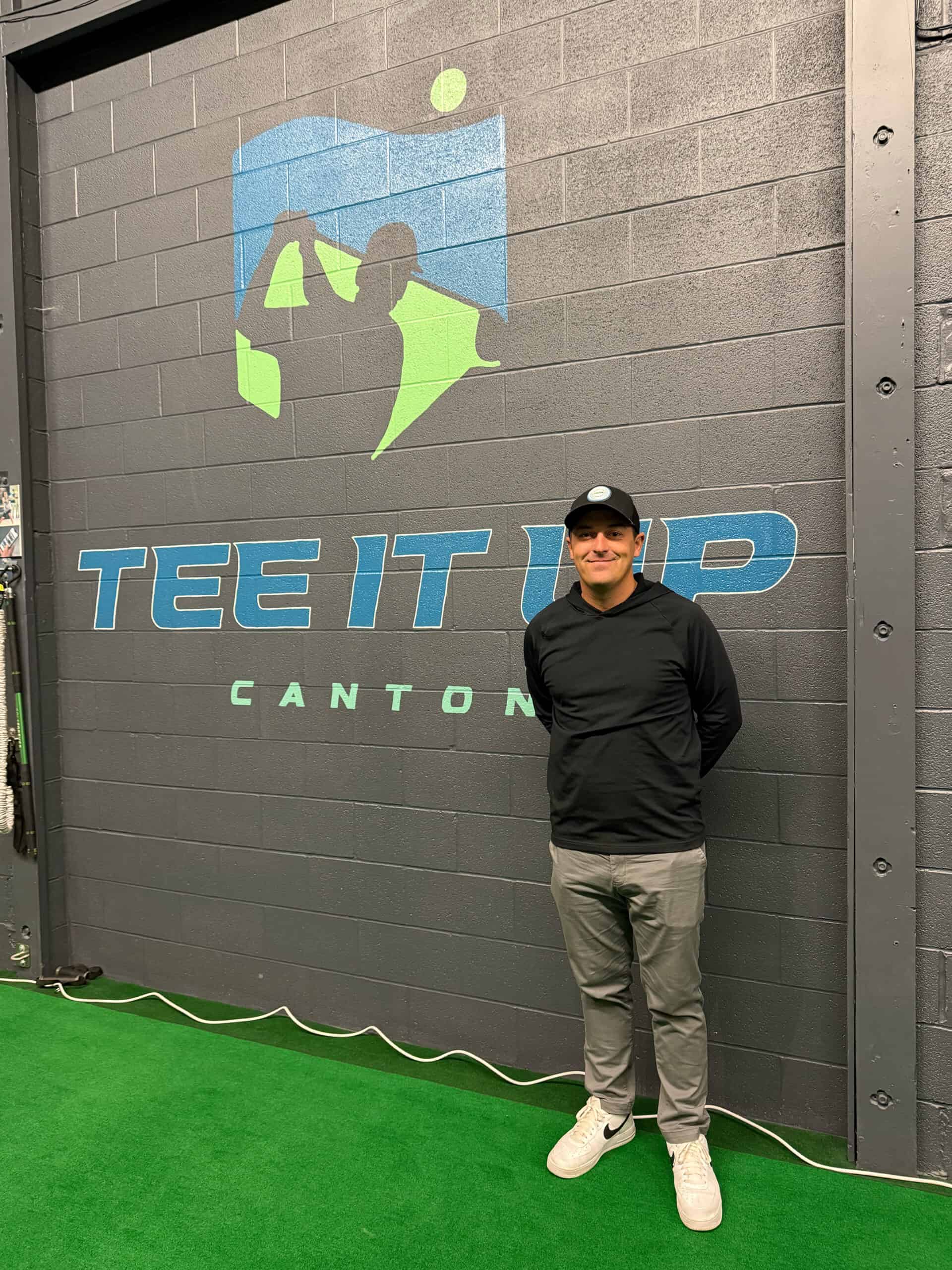On a cool December day in northeast Ohio, PGA Tour Pro Justin Lower strolled into Tee It Up Canton looking like many of our other customers.
He had his Malone golf bag in hand and wore clothes no different than we see here daily.
Except he’s not a normal golfer. He’s a professional. Here is his story.
Listen to the Full Interview
All right. Welcome to our first interview from Tee It Up Canton. My name is Connor Clay. We are an indoor golf facility here in Northeast Ohio, and I’m so honored to have a guest that I’ve admired for the last three years since I met him, Justin Lower, PGA Tour professional. Justin, thanks so much for being here.
Thanks for having me.
Of course. So how’s it going? I know you’re just coming off the fall swing of the PGA Tour. Were you happy with the results?
Yeah, for the fall, for sure. I had three top tens and made a majority of the cuts. My goal was to make all the cuts, but it was still a good year overall. I made over 20 cuts, which was nice. But I played a lot—31 events. It was a long season, so it’s nice to just sit back and chill right now.
Absolutely. 31 events? What’s an average PGA Tour schedule?
It depends on your world ranking. The better your ranking, the less you need to play. Everyone has to play at least 15 events to count it as an official season for retirement or pension purposes. With the new elevated schedule, guys can play less if they’re performing well. I’d say the average is probably between 22 and 27 events. I definitely played more than average, but I felt like I had to. There were certain things I was chasing, so hopefully, it pays off.
Well, we had a lot of fun watching you this fall. What are your goals for the 2025 season?
The Tour is making changes, shifting from the top 125 to the top 100, so my main goal is to ensure full status for 2026 by finishing in the top 100. The ultimate goal is to make the top 50 because that gets you into all the designated events and, ideally, the majors. I’d also love to win. I feel like I’m close and doing good things toward that. Winning is hard—only one winner out of 120–156 players each week. But it’s a big year for me since getting vested in the pension after five years would be huge.
A win would be amazing. Do you have a favorite course or tournament on tour?
There are a few. I love the Rocket Mortgage event in Detroit at Detroit Golf Club—an old-school Donald Ross course, kind of like Firestone but flatter. I also like the Mexico courses because they’re more open, giving me freedom off the tee. John Deere is another favorite; we had nationals there in college, so it’s special to me.
Those are some unique choices. It’s interesting that you like both tree-lined courses and wide-open ones. So, obviously, you’ve been doing this for a long time. Life changes as you grow up. What keeps you motivated to pursue your dream of being a PGA Tour Pro?
It’s something I’ve always wanted to do, and I love it. It’s not as glamorous as I thought, but it’s still amazing. Playing golf for a living, traveling the world, and seeing places I wouldn’t otherwise—like Scotland and Japan—is incredible. I get to experience unique courses, great food, and more. It’s been a blessing.

What’s one thing about PGA Tour life that would surprise average golf fans?
Most fans think our travel is covered or free, but it’s not. We’re independent contractors, so all expenses—flights, hotels, etc.—are on us. It’s organized but also chaotic. Not everyone flies private; many of us fly commercial or drive. My family often travels with me, and we look like gypsies with all our luggage.
That’s a funny image, but also surprising to hear. How has becoming a husband and then a dad impacted the way you approach golf?
Becoming a dad has had a bigger impact than becoming a husband. When Janise and I got married in 2019, I was still on the Korn Ferry Tour, just trying to move up. It changed a little—she was working, and we were both independent, grinding to get where we wanted. After our daughter was born, my perspective changed completely. It became more about her—making sure she’s happy and cared for, as well as ensuring Janise is comfortable on the road. We stay in Airbnbs more than hotels now for space, often traveling with other families with young kids. It’s fun and definitely takes a village.
I can relate. I just got married, and my wife has two kids, so I’ve realized it’s not about me anymore. Speaking of family, how did you first get into golf as a kid?
My dad cut down some clubs for me and took me out with my uncles. It was usually the three of them and me. I’d ride along in the cart, hit some shots, and eventually play full rounds. My first tournament was at a local course. My dad asked if I could still sign up, and they let me. I shot 61 for nine holes at eight years old and finished second. I was hooked from that moment.
Once it catches you, it really catches you. It sounds like you had a unique start, building courses and obstacle courses. Do you have a favorite junior golf moment?
My first tournament sticks with me. It wasn’t glamorous—I was so nervous I couldn’t eat breakfast and ended up dry-heaving on the course. Despite that, I finished second. My favorite memory, though, was winning my first junior tournament three years later at the same course. I woke up that day knowing I’d win and shot a 40 for nine holes to win by four or five shots. I wish I could play every round with that same confidence.
That’s incredible. You grew up playing at Lyons Den, a special local course. Can you describe it for people who might not know it?
It’s unique, depending on when you play. I’ve played it in snow and 100-degree heat. It’s not a country club, but it’s special to me. It taught me how to make birdies and be aggressive on the course. Over the years, it’s changed—the trees have grown bigger—but it still feels the same. I try to play it whenever I’m home, even if it’s just for fun.

A lot of kids here dream of becoming pros like you. What was the transition from college golf to pro status like?
It wasn’t smooth or glamorous. I turned pro in 2011 after graduating. The process is simple—enter a professional event and declare you’ll accept money if you place or make the cut. But I quickly learned there were many players better than me. I spent years on mini-tours, did Q-School six times, and worked my way up to the Korn Ferry Tour. I fell off it twice before finally earning my PGA Tour card in 2021 after a long, grueling two-year stretch due to COVID. It was emotional—happiness, tears, and relief all rolled into one.
What did it feel like when you finally got your PGA Tour card?
There were a lot of emotions, and I didn’t make it easy on myself. I was part of the 2021 class, but because of COVID, the 2020 and 2021 seasons were combined. It became one long season with 47 or 48 events. I played 41 or 42 of them. It was a grind. During the 2020 season, I was 19th on the points list, which would have been enough to graduate to the PGA Tour, but they didn’t have a graduating class that year because of COVID. Everything rolled over into 2021, and I dropped to 40th or 50th at one point, climbed back into the top 25, and then fell out again.
I finished the regular season at 30th—five spots outside the number. Thankfully, there were the Korn Ferry Finals events, which don’t exist anymore. I played well enough in those to get the final card, the 25th spot. It was a mix of happiness, tears, and relief—just the culmination of everything I’d worked for. It was a special moment.
That’s an amazing story. You and I have talked about being from Northeast Ohio and being Cleveland sports fans. Does LeBron’s quote, “In Northeast Ohio, nothing is given, everything is earned,” resonate with you?
Absolutely. That quote is etched on the yardage book cover I carry. I might not live my life by it, but I definitely live my golf life that way. I’ve had to earn everything in this game—nothing was handed to me. My journey has been one of perseverance, gaining perspective, and working hard. It’s been tough but rewarding. It might make for a good book someday!
As the professional golf landscape changes, how do you handle being on the bubble, especially with all the shifting goalposts?
Honestly, I’m not sure how I’ve done it. The goalposts keep shrinking, and it can be overwhelming. But I’ve learned to focus on myself and avoid getting caught up in the noise. Staying quiet and going about my business has been the best approach. There are moments when it feels easy and others when it feels impossible. The key is finding a balance and staying patient.
For young golfers who come here looking to improve—whether it’s making their high school team or breaking 40—what advice would you give?
Today’s young golfers have so many resources, especially through social media. YouTube, Instagram, and other platforms are full of great information. My advice is to find what works for you. Focus on speed—it’s a huge part of the game now. Short game and putting are also critical. Putting, especially, is a great equalizer. Above all, make sure you love the game and have fun. Golf can be brutal, but it’s incredibly rewarding if you stick with it.
Max Homa said recently, “If you’re an amateur golfer, this game is impossible. Just have fun.” Do you agree?
Absolutely. Golf can beat you down, but it’s also one of the most rewarding things you can do. There’s a reason why the PGA Tour has traveling sports psychologists. At times, the game feels easy, and at others, it feels foreign and impossible. You just have to keep going.
As an indoor golf facility owner, I have to ask: How have technology advancements helped grow the game for players at all levels?
The advancements are incredible. Facilities like this didn’t exist when I was in high school. Back then, there was talk of indoor golf, but it was just hitting balls into a net. Now, you can buy launch monitors that provide data for a few hundred dollars or invest in high-end simulators. The data is accurate, and people are putting simulators in their homes. For those of us in colder regions, facilities like yours are game-changers. The technology has made golf more accessible and enjoyable for everyone.
I agree. I love seeing how the game is evolving. Well, Justin, thank you so much for talking to me today. I really appreciate it.
Thank you. It’s been great.

Prologue
After our interview, Justin went out and hit a few balls. It’d been a little over a week since he touched a club, so he didn’t know what to expect.
We set him up on a few courses and holes, and he could call his carry distances to the exact yard. Needless to say, this guy is good.



